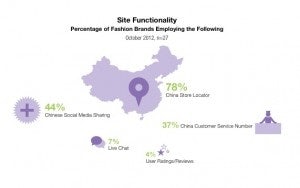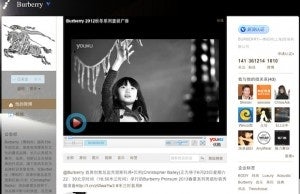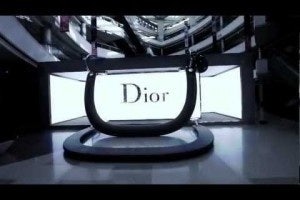E-Commerce Presents Opportunity "To Replace Bricks With Clicks"#
Despite the explosive growth of China's digital space and e-commerce market, the new Fashion supplement to

L2 Think Tank#
's Digital IQ Index: China report finds that most Fashion brands remain slow to adapt to the changing tides of Chinese luxury consumption. Although online apparel sales topped US$50 billion in 2012 and are projected to hit three times that by 2016, the supplement points out, only 41 percent of luxury fashion brands offer e-commerce in the country, with a paltry seven doing so on their official sites. This has left a void in the market which multi-brand retailers (both domestic and international) have jumped in to exploit.
Though Fashion brands are generally thought to be doing a decent job at digital marketing in China, L2 found that the vast majority of the 27 brands in the study -- 67 percent -- ranked in the "Feeble" category, and none made it into the "Genius" category. This indicates that, despite the strides made in recent years by brands, progress must be made on the innovation side.
Perhaps unsurprisingly, Burberry topped the supplement with a digital IQ of 124, owing to its adept use of Chinese social media and multi-platform campaigns. Specific examples of Burberry's digital strategy last year include using its Weibo page to promote its Burberry Body perfume and drive online fans to offline stores for product giveaways, as well as its last collaboration with location-based service Jiepang. Second-place Louis Vuitton (digital IQ = 118) was called out for high-profile initiatives like last summer's "From Paris to Shanghai" campaign (which ran for a week before the opening of the brand's first mainland Chinese Maison in Shanghai). Louis Vuitton also paired with Jiepang last year its “Meaning of Travel” (旅行的意義) campaign.

Other brands ranked highly in the top ten included Chanel (which gained points for its tie-up with popular actress Zhou Xun), Coach (which launched its own e-commerce site), and Dior (which debuted a Chinese-language version of its DiorMag last spring).
Though it sounds as if brands are not only highly active but also highly effective at hitting Chinese consumers where they live -- which is, increasingly, online -- the study finds that their hesitance to take advantage of new technologies and make simple tweaks to their strategies is hindering their efforts not just in terms of e-commerce but also marketing and even their official sites.
Fashion brand sites lag behind other categories in terms of load times (52 percent have load times of over 20 seconds), lack sophistication and suffer from poor translation, and few host their sites in China or have ICP certification -- key to boost site ranking on Chinese search engines. Brands can have all the name recognition in the world, but that doesn't necessarily translate to success in the digital realm; Diane von Furstenberg may have more than one million Sina Weibo fans, but without a Chinese-language brand site, DVF ranks 21st with a lowly digital IQ of 41.
Still, as Emma Li, research lead on L2's Digital IQ Index: China, told us, "Just having a basic site is not enough. Brands need to create more reasons for fans to visit their sites. Optimizing for search engines is key to drive traffic to websites, and social media is a new area for CRM. Finally, mobile has become a must."
Though the runaway success of apps like WeChat attests to the popularity of mobile services, few Fashion brands offer Android apps -- even though the operating system has 90 percent of market share in China -- and none of those are even in Chinese. The study adds that only 22 percent of Fashion sites are mobile optimized, 26 percent have HTML5 sites, and 52 percent are not mobile compatible. Considering mobile phones are the primary device for accessing the Internet in China and increasingly are being used for shopping, this is inexcusable. Although China’s mobile shopping market grew 488 percent year on year to $1.9 billion in the first half of 2012, L2 found that only three Fashion brands are e-commerce enabled on mobile and Burberry is the only brand to offer an end-to-end mobile-commerce experience in China.
Clearly, the opportunity is there for Fashion brands to invest in beefing up their mobile presence, whether that's via (Chinese-language, Android) apps or m-commerce. Many of them already taken steps in this direction, and already boast strong, effective digital marketing campaigns. So what are they so afraid of? As popular social media platforms like Sina Weibo and group messaging app

WeChat#
roll out payment systems, mobile capabilities are becoming more important than ever for retailers and brands alike.
However, as L2 notes in its Fashion supplement, many brands still have concerns about "counterfeits, cannibalization, and logistics" in the China market. Even multi-brand e-tailers are encountering obstacles despite the obvious potential, mostly due to China's stiff import duties, as Jing Daily wrote last week. China may, as Alibaba's Jack Ma recently put it, be poised for a "golden age" of e-commerce, yet, as Li of L2 told us, "Most brands are waiting to see what their competitors will do." Still, as Li adds, "It'll be the first movers who will benefit from getting the market insights first-hand."
Despite slow momentum, expect to see more brands getting more aggressive out of market necessity. As Li concludes, "We anticipate the number of Fashion brands that will incorporate more mobile and e-commerce features to increase dramatically over the next year or two."
